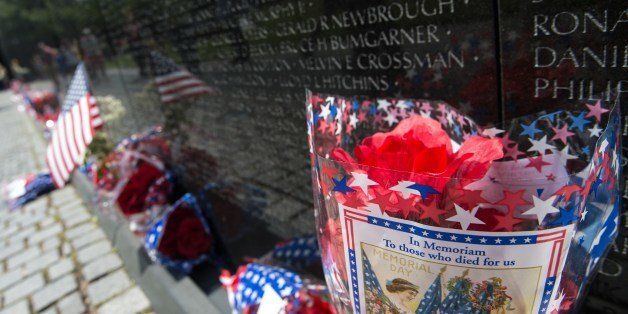
The Vietnam Veterans Memorial Wall is two years older than I am. For as long as I've known there was a Vietnam War, I've known that people leave objects at the Memorial. The first time I saw any of those mementos they were behind glass and professionally curated at the Smithsonian Museum of American History. But it wasn't like other exhibits. The bamboo cage covered in broken glass -- full size, but horrifyingly small -- wasn't a historical object, but a way of remembering and telling a story. Someone reaching out with his or her pain, hoping I would share it just a little. By the time I saw it, the decision had already been made to remember the war this way-- with a long, shiny black wall of names, and pieces of pain venerated behind glass. Differently from the way any other war is remembered in Washington, before or since.
So when Washingtonian magazine assigned me the story of the man who keeps those objects, it was also an assignment to take a foregone conclusion of my childhood and figure out why and how it came to be.
I had absorbed the cultural resistance to talking about the war. I knew there was tremendous anger, even still. I knew it wasn't a good idea to ask people about it. I knew that the stories were painful, and that this war in particular was difficult to talk about and difficult to hear about. I was, without really thinking about it, someone who didn't want to hear the stories, who was so far removed from them that it seemed better not to pry, not to ask for information. I assumed I would never really understand, and I protected myself by not really trying, not finding anything to take personally about the experience other people had had.
The way I had learned about other wars, in history class and in movies, wasn't like those objects at all. History remembers great men; soldiers advancing, retreating, learning to kill and being killed, of maps turning from one color to another, of brotherhood and manhood, weapons, tactics and consequences. And I was never going to be a great man.
The mementos, though -- well, they weren't exactly "mementos," which are memories you keep. These things were memories you give away, memories you discard through sharing. These mementos created a fully democratic history of the war. Any person who can physically get to the wall to leave something behind is automatically a part of history and the way America memorializes the people we lost. Most objects are left with no identifying information or explanation attached. They allude to the larger history of war as it ever has been, not just the movement of troops but the people who miss each other, the prized and sparse material comforts, the reminders of home.
The collection is massive, ungainly, impossible. They keep everything that won't rot. But the why and the how of America remembering this war becomes clear as soon as an object reaches in and grabs you by the heart.
I never saw the boo-boo bunnies. They aren't on display anyplace. I only know about them because the day a man lifted them out of the box of things left at the wall, a reporter happened to be there. They were a pair of carefully, specially folded washcloths. Both folded the same way. The curator had no idea what to make of them. Fortunately, there happened to be a volunteer on hand who knew them immediately.
Boo boo bunnies are for small injuries and wounds. They are washcloths meant to be wrapped around a piece of ice, to protect your scrape while Mommy numbs it. They are bunnies, which makes them nonthreatening even if the ice hurts a little. They are one of the powerful ways Mommy makes things okay when you're hurt.
There's no way to prove who left the boo boo bunnies, and no way to prove for whom. But I know, deep in my bones, the story they tell. There was a brave Mommy. She had a little boy she loved very much. She made him into a good man. And she gave him up, gave him up to the world. One day, he got hurt very bad, and Mommy wasn't there. She didn't even know it was happening. He was hurt, and she wasn't there to make it okay. She kept the bunnies, though, for ten years or more after she heard he died. And one day she gave them up, too.
Those bunnies tore through every layer of alienation from the war I had. Without any words at all. I knew their story, purely from the haphazard, illogical and utterly perfect way America remembers these dead.
There was a very brave Mommy who gave up everything she had. What more is there to know.
The Livingston Awards for Young Journalists aims at identifying top talent early (entrants must be under 35) and boosting winners by presenting them to the senior levels of the profession at an annual lunch in New York City. For more information on the program, run by the University of Michigan and supported by the Knight Foundation, read here.